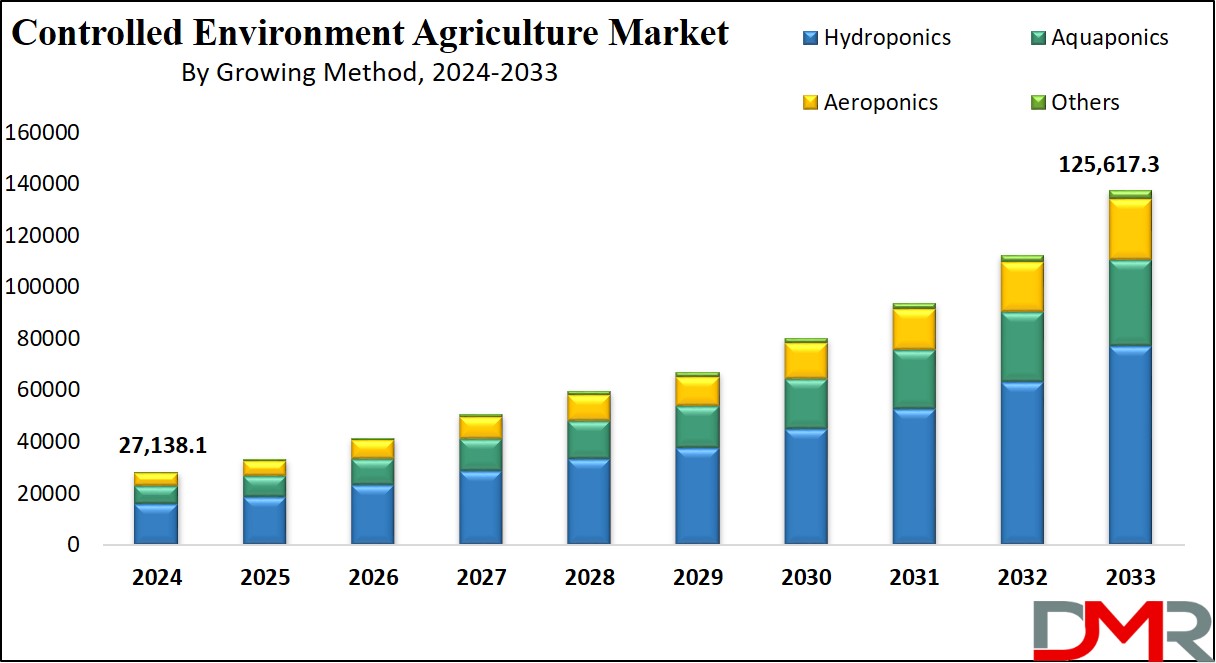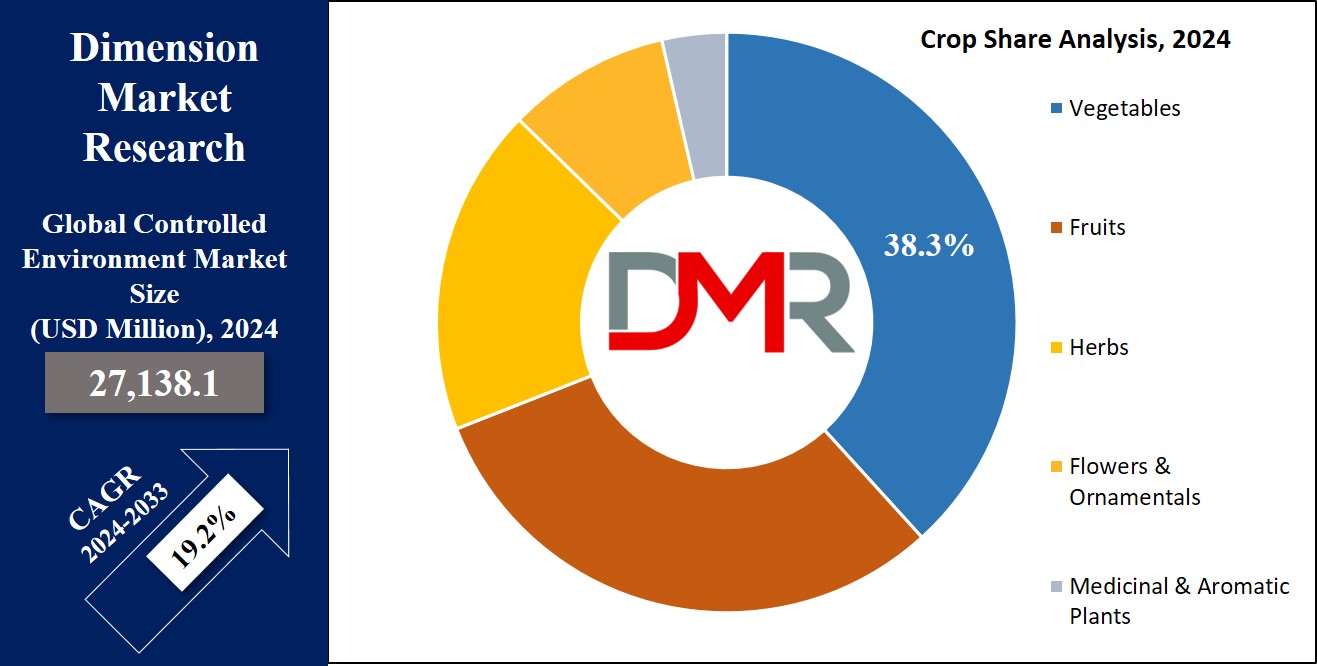
Additionally, supportive authority’s policies and incentives encourage controlled environment agriculture adoption. However, excessive preliminary investment fees, technical complexities, and restricted awareness in some areas pose challenges. Despite this, the controlled environment agriculture market is characterized using innovation and growing international adoption, indicating vast growth capacity within the foreseeable future.
Key Takeaways
- Market Size: The global controlled environment agriculture market is forecasted to have a market value of USD 31,599.6 Million in 2025 at a CAGR of 19.2%.
- Market Definition: The sector focused on indoor cultivation methods, using technology to regulate environmental factors for optimal crop growth.
- Offering Segment Analysis: Lighting systems are expected to dominate this market with the highest market share in 2024.
- Growing Method Segment Review: In the context of growing method hydroponics are expected to dominate this market with 52.3% of the market share in 2024.
- Growth Factors: Growth factors in the Global Controlled Environment Agriculture Market include increasing demand for fresh produce, technological advancements, rising concerns over food security, and supportive government initiatives and incentives.
- Regional Preview: North America is anticipated to dominate this market with 34.1% of market share by the end of 2024 followed by Asia Pacific which exhibits a substantial growth with the highest CAGR.
Use Cases
- Urban Farming: Utilizing vertical farming techniques to grow crops in urban areas, maximizing space and providing fresh produce locally.
- Year-Round Production: Enabling consistent crop yields regardless of season or climate through controlled environmental conditions.
- Resource Efficiency: Minimizing water utilization and reducing environmental effects with the aid of optimizing nutrient transport and energy consumption.
- Crop Optimization: Tailoring environmental variables such as light, temperature, and humidity to enhance crop quality, yield, and nutritional value.
- Food Security: Providing a reliable and sustainable food supply, especially in areas facing agricultural demanding situations like droughts, land shortages, or intense climate events.
Market Dynamic
The global controlled environment agriculture (CEA) market is experiencing a dynamic boom pushed through increasing demand for domestically grown, fresh produce, coupled with growing concerns over food security, water scarcity, and climate change.
Advancements in technology, which include LED lighting fixtures, hydroponics, and vertical farming, have revolutionized controlled environment agriculture practices, permitting green and sustainable crop production. These advancements have strong linkages with both the
Agriculture Equipment, through integrated smart systems, and the Agriculture Biotechnology Market, through crop genetics optimized for indoor cultivation.
Furthermore, supportive authority’s rules and regulations, along with developing investments from both public and private sectors, are fueling market expansion. Consumer preferences for pesticide-free, top-notch produce are also being adopted. However, demanding situations which include high preliminary investment expenses, technical complexities, and restricted attention in some areas pose limitations to marketplace growth. Overall, the controlled environment agriculture marketplace is characterized by using fast innovation, evolving client trends, and increasing global adoption, indicating massive growth potential in the coming years.
Research Scope and Analysis
By Offering
Lighting systems are projected to dominate the offering segment in the controlled environment agriculture (CEA) market mainly because light is one of the most vital elements influencing plant growth & development. In indoor and greenhouse settings, natural daylight may be inadequate or inconsistent, necessitating synthetic light solutions. LED light systems, especially, have gained prominence due to their power efficiency, customizable spectra, and ability to imitate herbal daylight, selling the most desirable plant boom throughout numerous increase stages.
Moreover, advancements in the LED era have led to the development of tailor-made lighting fixtures answers optimized for particular crops, maximizing yields and niceness. As lights are fundamental to CEA operations and without delay impact crop overall performance, it stays the dominant supplier in this segment, driving innovation and market growth.
By Crop
Vegetables are the leading segment in the controlled environment agriculture (CEA) market in the crop segment with 38.3% of market share in 2024. This dominance is primarily due to their widespread consumer demand, high market value, and suitability for indoor cultivation. Firstly, tomatoes have a consistent year-round demand in the market, making them an attractive choice for CEA growers seeking reliable revenue streams.

Additionally, tomatoes often command a higher market value compared to other crops, especially when grown using advanced CEA methods instead of traditional agriculture methods. Furthermore, tomatoes thrive in controlled environments where factors like temperature, humidity, and light can be optimized, resulting in market demand, higher yields, and superior-quality produce. Their versatility in growing systems, including hydroponics and aeroponics, makes them suitable for various CEA setups, maximizing production efficiency.
Finally, consumers prefer locally grown tomatoes due to their freshness, taste, and nutritional benefits, driving demand for controlled environment agriculture-grown tomatoes. Overall, the combination of consumer demand, market value, suitability for controlled environments, and consumer preference solidifies tomatoes' dominance in the crop segment.
By Growing Method
Hydroponics is projected to dominate the controlled environment agriculture (CEA) marketplace in the context of the growing method with 52.3% of the market share in 2024 due to its proven track record, scalability, and versatility. Firstly, hydroponic structures offer better yields and faster increase charges as compared to traditional soil-based total farming, making them appealing to commercial growers searching for efficiency and productivity.
Secondly, hydroponics calls for much less water than soil-based totally agriculture, addressing concerns over water scarcity and environmental sustainability. Additionally, hydroponic setups may be without problems tailored to various scales, from small urban farms to big business operations, facilitating significant adoption. The absence of soil in hydroponic systems reduces the hazard of soil-borne pests and illnesses, minimizing the want for chemical pesticides and making sure more healthy produce.
Lastly, hydroponics allows for unique manipulation over nutrient transport and environmental elements, resulting in regular crop fine and year-spherical manufacturing abilities, similarly solidifying its dominance within the controlled environments agriculture marketplace.
The Controlled Environment Agriculture Market Report is segmented based on the following:
By Offering
- Lighting Systems
- Heating Systems
- Growing Media
- Nutrients
- Others
By Crop
- Vegetables
- Fruits
- Herbs
- Flowers & Ornamentals
- Medicinal & Aromatic Plants
By Growing Method
- Hydroponics
- Aquaponics
- Aeroponics
- Others
Regional Analysis
According to the industry analysis North America is expected to oversee the largest market growth where it will
hold 34.1% of market share in 2024. The increasing global demand for this market in the North American region dominates the controlled surroundings agriculture (CEA) marketplace due to various factors. The location benefits from robust technological innovation, tremendous investment, and supportive regulatory surroundings.
The growing need for locally sourced, fresh produce, coupled with urbanization and land constraints, has fueled hobbies in controlled surroundings and agriculture strategies like vertical farming. These trends also complement broader developments in the Agriculture Equipment Market, where North America leads in automation technologies, and the
Agriculture Biotechnology, where regional innovation pipelines drive genetically optimized crops for indoor growth systems.
Additionally, North America's well-set-up studies and improvement infrastructure contribute to improvements in controlled surroundings agriculture tech and practices. This place's leadership in CEA is similarly solidified by using growing consciousness among consumers and enterprise stakeholders approximately the advantages of CEA, including twelve months-spherical production, decreased environmental impact, and stepped forward food safety.
Following North America, Asia Pacific is projected to hold the highest CAGR due to which it accounted for the largest revenue share in 2024. This dominance is due to the rapidly growing population which is directly correlated to the food security issue.
By Region
North America
Europe
- Germany
- The U.K.
- France
- Italy
- Russia
- Spain
- Benelux
- Nordic
- Rest of Europe
Asia-Pacific
- China
- Japan
- South Korea
- India
- ANZ
- ASEAN
- Rest of Asia-Pacific
Latin America
- Brazil
- Mexico
- Argentina
- Colombia
- Rest of Latin America
Middle East & Africa
- Saudi Arabia
- UAE
- South Africa
- Israel
- Egypt
- Rest of MEA
Competitive Landscape
The global controlled environment agriculture (CEA) market features an aggressive panorama characterized by numerous key gamers. Signify (previously Philips Lighting) leads with tailored LED lighting solutions for indoor, greenhouse, and vertical farming. AeroFarms makes a specialty of sustainable vertical farming with the use of aeroponic structures. Indoor Harvest Corporation designs modular CEA structures for indoor farming, whilst Heliospectra AB offers advanced LED lighting fixtures and management software.